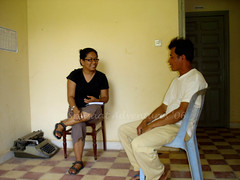While the Kamchai Mear Pilot Project made a strong start implementing the first steps, Krong Kep Pilot Project had a delayed start in implementing activities due to some unavoidable circumstances.
Now that these circumstances had been resolved, and the formalities had been done, with Project Manager CSH endorsing me to the Deputy Governor of Damnak Chang'eur, it will be a solo work for me from here and onwards. I will have to rely on my limited Khmer vocabulary, and the kindness, patience and trust of the people whom I will be talking to in the coming days when I attempt to establish relationships and contacts in their community.
As a methodology, iREACH will be utilizing various Participatory Development Communication (PDC) tools in approaching and involving these two pilot project sites and together identify strategies, and for us the project staff to improve communication with them and other stakeholders.
According to Guy Bessette, in his book, Involving the Community: A Guide to Participatory Development Communication, has this definition of PDC:
Participatory Development Communication (PDC) is a planned activity based on the one hand on participatory processes, and on the other hand on media and interpersonal communication, which facilitates a dialogue among different stakeholders, around a common development problem or goal, with the objective of developing and implementing a set of activities to contribute to its solution, or its realization, and which supports and accompanies this initiative.
PDC follows a number of steps, the first of which is establishing a relationship with local community and understanding the local setting.
And so the question, how did we initiate contact with the two pilot sites?
A lot of work that has been done in both pilot areas were building relationships with local authorities and this, we believe, was important in laying down the foundations for our community work: In the Cambodian setting, visiting the authorities is like an unspoken requirement in order to enter the community. Visits or meetings such as what the project staff did is important as it shows recognition and respect to the authorities, apart from informing them of the project, asking for their endorsement and cooperation, as well as getting their opinion on the project being introduced.
In the Cambodian setting, visiting the authorities is like an unspoken requirement in order to enter the community. Visits or meetings such as what the project staff did is important as it shows recognition and respect to the authorities, apart from informing them of the project, asking for their endorsement and cooperation, as well as getting their opinion on the project being introduced.
The attitude that the staff showed to these authorities at this initial phase will spell out whatever relationships we establish with them and with the community in the future. It also helped us enter the community easily and talk to the villagers when the villagers knew that we had already communicated with their leaders, so this is why we didn't go directly to the villagers. Even my counterpart in Kamchai Mear could attest to this.
Initially, I thought that my being a foreigner would pose a difficulty in carrying out my tasks. However, the more I immersed myself in the community, the more comfortable the villagers were with me. My Khmer language proficiency was just enough (a level above struggling) for me to carry on conversations, but most of all, the very fact that I look like them (dark skin, small eyes, black hair), I was easily trusted. It also made it easier for me to interact with them, allowing me to enter their homes, and collect information unobtrusively. However, in some instances, my moto-dop driver helps in interpreting/translating some parts of conversations.
We also met with the different government line agencies in the district level. We did this to gather secondary information to support/verify the information we collected from the community.
The staff in both pilot sites spend more time in the community, talking to the villagers - farmers, students, fisherfolks, women, to name a few, and more often, participating in community social activities.
For example, during the Water Festival, I and the volunteer-enumerators from MVU were invited by a local monk to participate in their Bok Ambok festival celebrated in their pagoda. It was such a huge event in Kep where almost all people from different districts come and celebrate the event in the pagoda. Bok Ambok festival is something like a harvest festival coinciding with the full moon. The highlight of the event is the pounding of newly harvested rice into ambok (pinipig in the Philippines) and at the turn of midnight, offer a prayer with the local monk leading the crowd.
So far, the initial work, i.e., understanding the community and the situation in the community had been done, and still is being done. It's going to be a continuing process. I would like to end this post with this:
The idea behind PDC is the use of participatory communication as one of the tools for development. The way the communication is established and nurtured will affect how involved people will feel about the issues raised and how they will participate - or not - in a research or dvelopment initiative or project.
- Guy Bessette, Involving the Community, A Guide to Participatory Development Communication)
Tuesday, December 5, 2006
Establishing relationships in the Community
Posted by
Zarah
at
5:47 PM
1 comments
![]()
Labels: PDC, Reflection
Subscribe to:
Comments (Atom)